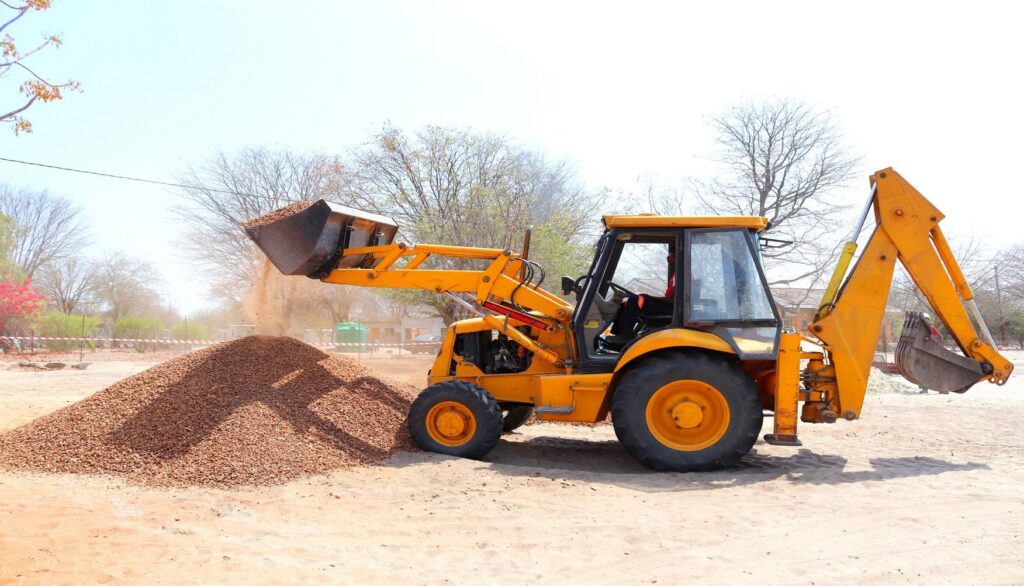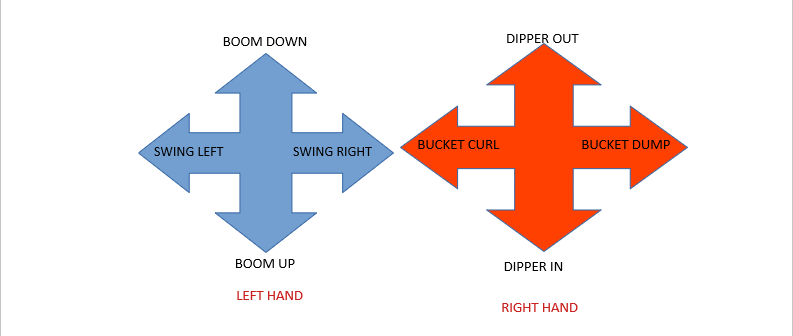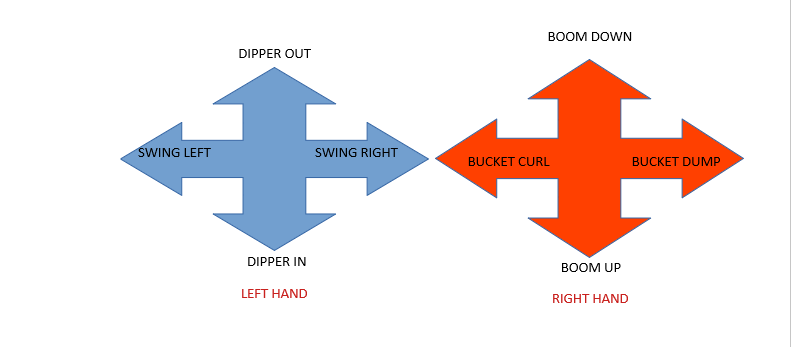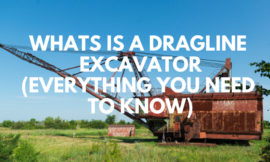Whether you are clearing a large area full of trees and stumps or you have a pile of snow to clear from your farm or perhaps, you might be digging a trench that requires heavy digging, one common headache that you are sure to face is choosing between an excavator and a backhoe.
Both are powerful diggers that can be fitted with other tools that increase the range of work they can do and they both pack a bit of power. But just how do you choose between an excavator and a backhoe?
That’s where I come in, I’ll walk you through the following :
i. What’s an excavator?
ii. What’s a backhoe?
iii. Differences between an excavator and a backhoe?
iv. Choosing between an excavator and a backhoe
v. Which is better, a backhoe loader or an excavator?
vi. Backhoe vs excavator controls
vii. Backhoe or excavator for land clearing
viii. Backhoe vs excavator for farm use?
ix. Backhoe or excavator for digging stumps?
What’s an excavator ?
An excavator is a digging machine that features a boom, dipper, chassis, and a digging bucket. The excavator is built to mainly use its digging arm and thus, is better suited to heavy-duty projects like mining, demolition, driving piles, rock blasting, and drilling shafts, etc.
The cabin can rotate up to 360 degrees allowing the operator to turn the machine in any direction they are working.
It can also be used to perform other tasks asides from digging as the excavator can be outfitted with other attachments like dozers, graders, brush cutters (forestry projects).
Excavators are typically large and need to be transported using a carrier vehicle. For this reason, they aren’t suited to operations that require the excavator to be transported between different sites during the project.
What’s a Backhoe ?
A backhoe is a machine that has a bucket loader on one end and a front loader on the other. It has two small tires on the bucket end and two bigger tires at the front loader end.
The loader arm is only able to rotate 200 degrees but the seat in the cabin can rotate 360 degrees so the operator can see the side he/she is using. They are typically used in farming, snow removal, small and medium scale excavation, and construction projects.
They can be fitted with hammers, breakers, rippers, rakes, drills for extra functionality. The front loader can also be fitted with a forklift, broom, plow, etc.
Backhoes are generally smaller and many backhoes can be driven on public roads. This makes them ideal for projects that will require moving the backhoes between multiple worksites during the course of the project.
However, some excavators are fitted with tracks and they are called “trackhoes”.
Differences between an Excavator and a Backhoe
Although both machines are quite similar in functionality, there are still some key features that differentiate both machines, and understanding those differences will guide your choice of machine.
- Size : Backhoes are generally smaller than excavators and weigh less, this makes them easier to transport. Also, backhoes are generally suited to working in confined spaces better than their excavator counterparts who are larger and better for more spacious projects.
- Mobility : Backhoes are generally easier to transport than excavators as they can be driven on public roads whereas excavators have to be transported on trucks. This is particularly important if your project requires transporting the machines between multiple worksites.
- Rotation : While the backhoe’s arm can rotate up to 200 degrees, the excavator can rotate a full 360 degrees giving the operator full maneuverability and saves time that would have been spent on adjusting the machine regularly.
- Adaptability : Backhoes and excavators can both be fitted with other parts that increase the kind of work they can do but backhoes generally have a wider range of parts that can be added to them as compared to excavators. This makes backhoes generally more versatile.

Choosing between an Excavator and a Backhoe
So finally, you want to pick the right machine for your next project. You’ve seen what each of them can do and you’ve seen the key differences between them but perhaps you’re still confused as to which of them is perfect for your project.
Here are a few guidelines to consider :
Size :
The size of your project should guide your choice of equipment. Will your project require heavy-duty digging and excavating e.g., mining, demolition, etc? Then an excavator would suffice.
Perhaps, you need a machine for farming, snow removal, or any other small/medium scale excavation, then a backhoe would be perfect.
Mobility :
Will your project require that you move the machine between multiple sites with some distance between? Then a backhoe would do just fine.
On the other hand, your project might not require so much movement and would be practically done in one place, in such a case, the excavator is the right one for the job.

Versatility :
Look at your project requirements and see if it would require other types of equipment like dozers, scrapers, etc., and also the range of additional equipment it would need.
For instance, backhoes are generally suited to farm work as they can be fitted with more tools than an excavator.
Whereas, excavators are better suited to large scale digging work demolitions and but they can be fitted with tools like brush cutters for forestry projects. In general, backhoes offers a wider range of additional attachments than excavators.
Budget :
Looking at your project’s budget can help you determine the perfect machine for the job. In general, standard backhoes cost less than standard excavators.
This also goes for owning, maintenance, storage, renting/leasing, etc. Backhoes are best for tight budgets.
Talking to an expert :
Finally, talking to a heavy equipment expert is one of the best things you can do. Talking to an expert can remove all the confusion and make sure you complete your project successfully and safely.
You can find such heavy equipment experts at rental companies or better still, you could speak to a construction manager at a site or at a construction company.
Which is better, a Backhoe Loader or an Excavator
The best answer to that question is; “it depends on your situation”. While excavators do pack more power and backhoes are more versatile, what you choose would depend on three main factors; size, type of your project, your budget and your time.
Backhoes generally would do most jobs that an excavator can do but with backhoes, you would have to take more time especially when working on demanding projects like clearing huge stumps.
Not taking extra time needed when working on such demanding projects might damage the backhoes and would likely result in extra repairs.
However, if you only have some light to medium farmwork or a huge pile of snow to remove, then an excavator would be perfect.
It’s smaller size, wider versatility and easy movement makes it excellent for farm projects and other less demanding jobs.
Backhoe vs Excavator Controls
Backhoes and excavators typically feature a hydraulic system that it responsible for the heavy lifting. It uses an incompressible liquid, usually oil, to transfer force from one piston to the other.
The two variables in the system are force and distance. This means that when the operator is using the joystick to move a piston, he/she has to balance both the amount of force on the piston and the distance being moved by that piston in order to get work done.

The backhoe needs to be working constantly so it needs constant oil pressure. It gets this pressure from an oil pump that is powered by a hefty diesel engine.
The more recent excavators now come with “Variable Displacement Pumps” which feature a “load sensing system” which only pumps oil according to when it senses a load and how much load it senses.
This helps to increase fuel efficiency by as much as 7-8%. The advantage of the hydraulics system is that since the fluid is incompressible, almost all of the force is being transferred resulting in little to no loss of transferred force unlike some other systems where some of the transferred force is lost.
Backhoe vs Excavator Controls
There are two main control patterns used by backhoes and excavators :
International Standard of Organisation (ISO) :
This control pattern is more commonly used by excavators. This control pattern is the most common used among heavy equipment operators and it’s very common in many nations hence the name ISO.
It’s main feature is that the right hand stick controls the main boom and the bucket while the left hand joystick controls the swing and stick boom.
ISO OPERATING SYSTEM

EXCAVATOR CONTROLS
INTERNATIONAL ORGANIZATION OF STANDARDS (ISO)
| HAND MOVEMENT | CONTROLS |
| Left Hand Left | Swing Left |
| Left Hand Right | Swing Right |
| Left Hand Forward | Stick Boom (Dipper) Away |
| Left Hand Backward | Stick Boom (Dipper) Close |
| Right Hand Left | Bucket Curl in (closed) |
| Right Hand Right | Bucket Curl Out (dump) |
| Right Hand Forward | Main Boom Down |
| Right Hand Backward | Main Boom up |
Society of Automotive Engineers (SAE)
This control pattern is what most backhoes use and it is sometimes referred to as “backhoe controls or john deere controls”. This type of control is more common in the united states. SAE controls are very similar to ISO controls with only a few differences .
SAE OPERATING PATTERN

BACKHOE LOADER CONTROLS
SOCIETY OF AUTOMOTIVE ENGINEERS (SAE)
| HAND MOVEMENT | CONTROLS |
| Left Hand Left | Swing Left |
| Left Hand Right | Swing Right |
| Left Hand Forward | Main Boom Up |
| Left Hand Backward | Main Boom Down |
| Right Hand Left | Bucket Curl in (closed) |
| Right Hand Right | Bucket Curl Out (dump) |
| Right Hand Forward | Stick Boom (Dipper) Away |
| Right Hand Backward | Stick Boom (Dipper) Close |
Most machines are equipped with a switch that allows you to move the hydraulic cylinders so you can switch between both control patterns thereby leaving the control type to the operator’s preference.
Backhoe or Excavator For Land Clearing
When it comes to land clearing, excavators would do a better job than backhoes if the land to be cleared is large. However, if your budget is tighter or you have more time to work with, then a backhoe would be a fine option.
But remember to take the work more slowly than you would on an excavator.
Forcing a backhoe to work like exactly like an excavator i.e working at an excavator’s pace) would be dangerous to the backhoe and would likely result in damage.

Backhoe vs Excavator For Farm Use
Backhoes are generally better for farm use than excavators.
Their smaller size and wider versatility makes them ideal for a large number of farm operations. Also, they won’t have a hard time moving around a farm which saves time.
However, if the farm work is large e.g clearing huge stumps or clearing a large area of land and you don’t have much time to work with, then an excavator would be perfect.
But if your budget is tight, then it’s best to go for a backhoe. Just remember that you would have to be more patient as any unnecessary rushing might damage the backhoe.
Backhoe or Excavator for Digging Stumps ?

When it comes to stump removal, excavators would do the job better than backhoes. But again, this comes down to your particular situation.
If you are working with a smaller space and the work isn’t as difficult or you have the time, then you can go for a backhoe.
However, if the work is large and you are pressed for time and don’t have any budget constraints, then an excavator would be perfect as they are better suited to heavy duty work.





